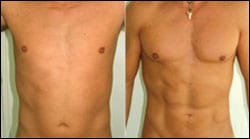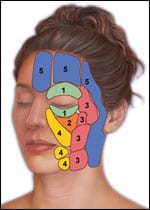 |
Light BioScience® LLC, Virginia Beach, Va, announces that its GentleWaves® light-emitting diode (LED) Photomodulation system has received 510(k) over-the-counter clearance for the treatment of periorbital wrinkles.
“GentleWaves is a comforting product,” says Brooke Seckel, MD, a plastic surgeon who practices in Boston. “It reduces the downtime following CO2 or erbium laser resurfacing. It also reduces inflammation by 30% to 50%. Feedback from patients was that it reduced redness and made recovery easier.”
GentleWaves reduces the appearance of fine lines and wrinkles through the use of a patented system of pulsating amber-colored LEDs that activate cells, causing them to produce collagen and elastin while decreasing enzymes that break down the skin. By building collagen, wrinkles are reduced and the skin retains a more youthful appearance.
The device was invented by David H. McDaniel, MD, director of the Institute of Anti-Aging Research and assistant professor at Clinical Dermatology and Plastic Surgery, in Eastern Virginia Medical School, Virginia Beach, Va.
Unlike laser and intense pulsed light therapy, the GentleWaves LED Photomodulation system does not use heat. Therefore, patients are not subject to the downtime that is associated with thermal wound-healing.
To get patients’ skin looking youthful, a series of GentleWaves treatments is required. The number of visits may vary depending on the problem being treated. Since the skin continues to age, maintenance treatments are necessary to prolong and enhance healthy skin.
According to the company, the benefits of GentleWaves is so promising that the company is currently investigating treatments for wound healing, radiation dermatitis, acne, thinning hair, and ophthalmic disorders.
Treatments using GentleWaves technology are virtually painless and take less than 5 minutes. It is suitable for all skin types.
According to Seckel, treatments using GentleWaves are less expensive than other light-based therapies.
“LED technology costs about less than half and 35% the cost of comparable laser light therapy,” he says. “It’s a slam dunk for practices who can’t afford these expensive lasers.”
SCULPTING TECHNIQUE HIGHLIGHTS 3D MUSCULAR ANATOMY OF PATIENTS
Alfredo E. Hoyos, MD, a plastic surgeon in Bogota, Colombia, and a member of the Colombian Society of Plastic, Aesthetic, Maxillofacial, and Hand Surgery, developed a body sculpting technique called vibration amplification of sound energy at resonance—VASER-Assisted High Definition LipoSculpture, or VASER® Hi Def™.
The procedure creates a sculpted, athletic appearance in males and females by precisely removing both superficial and deep fat around muscle groups in order to enhance the visibility of the underlying musculature.
“VASER Hi Def is an advanced body contouring technique that requires an in-depth knowledge of the superficial anatomy and the treatment of different fat layers,” Hoyos says. “The procedure enhances the body contour, similar to 3-dimensional sculpting, by taking into account the shape and form of structures underneath the skin that create an athletic contour.
“The system represents a quantum technological leap because it selectively liquifies the fat and allows the surgeon to target specific fat layers to create the desired sculpted appearance of the muscles without damaging connective tissue,” he notes.
In the study, deep and superficial infiltration and emulsification were performed in 306 patients using VASER technology in continuous mode for high debulking and in pulsed mode at lower power for more delicate areas and the immediate subdermal plane.
Debulking was performed using ventilated cannulas, beginning in the deep layers and continuing to the midlamellar layer and between muscle groups.
Superficial emulsification was performed to define the relevant anatomy for the muscle groups in each treatment area.
Transitioning was then performed to define the superficial anatomy landmarks by debulking some of the remaining fat over the muscles and smoothing the surfaces over the midlamellar area.
Hoyos reports that satisfactory results were obtained in 257 patients. No cases of skin necrosis occurred. Minor complications included 20 cases of seroma, nine cases of port site burns, and five cases of prolonged swelling.
VASER Hi Def is attracting patients who are already fit, but need an extra boost to enhance the look of their muscles. Good candidates for the procedure are patients who currently maintain a healthy lifestyle through diet and exercise, but are unable to achieve the desired definition.
|
See also “The Trend Setter” by Rich Smith in PSP, May 2007. |
VASER Hi Def can be performed on multiple body areas including the abdomen, the female breast, the male chest, the back, the arms, the thighs, the buttocks, the hips, and the waist.
Physicians report the first evidence of improved muscle definition 2 weeks after the procedure, and final results in 3 to 4 months.
According to Hoyos, the procedure is an aggressive approach to body contouring. It is difficult and time-consuming, and it should be performed only by physicians with extensive training and experience.





